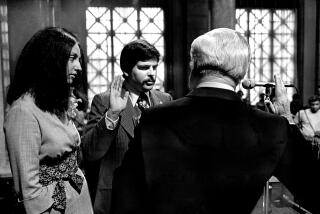Pocket ingenuity
A few things the pocketknife can do: Whittle, repair eyeglasses, scratch a first love’s initials into a sycamore and, should the occasion arise, amputate your right arm.
The pocketknife was not designed for a specific task, but for a single purpose: to be handy. Which may be why, despite assaults on its reputation, it thrives -- a symbol of simplicity and American self-reliance, even at this hyper-cautious, politically correct, broadband moment.
A backlash against pocketknives began after menacing juveniles brandished blades in “Rebel Without a Cause” and “West Side Story.” Cautious principals banned any kind of knife from the schoolyard. Four decades later, Sept. 11 left non-evildoing travelers staring in bewilderment as airport guards confiscated the whittling/nose hair-trimming combos from their pockets -- 1.8 million knives snatched from purses and pockets in 14 months, the bulk of them the Swiss Army style, according to the Transportation Security Administration. Yet Scouts, Boy and Girl, still instruct their campers in the pocketknife’s proper use (always present it handle first, even if closed; a sharp blade is safer than a dull one because it is less likely to slip and wound). And the little folding blade is standard issue on space shuttle flights and on the international space station. (It’s good for opening food packets, says NASA.)
Every year or so, the media offer another installment of the “pocketknife as a lifesaver” story -- a tracheotomy at 30,000 feet, an attacking cougar slain in British Columbia’s backwoods and last spring’s archetypal tale of a Colorado hiker, an 800-pound boulder and the blade of a Leatherman knockoff to the rescue.
“The pocketknife makes a connection to the oldest of American values -- the individual who manages by the strength of their wits to master their environment,” says Simon J. Bronner, a professor of American Studies at Penn State Harrisburg in Middletown, Pa. “The knife in your pocket is to be used for any situation, any circumstance, to figure out a solution for the problem at hand.”
At the turn of the 20th century, the pocketknife was a boy’s first tool, his introduction to the adult world. The young hand that whittled an arrowhead was preparing his older hand for fixing a tractor’s gearbox. The knife was supposed to foster creativity, says Bronner, author of “Carver’s Art: Crafting Meaning From Wood.” As society turned urban and mechanized by the mid-1920s, pocketknives mutated, sprouting sewing needles, awls or screwdrivers. Still leading this laudable, sometimes laughable, endeavor is the Swiss Army knife, manufactured by Victorinox. The company sold more than 3 million pocketknives last year, including the Classic SD (blade, scissors, toothpick), the Broker (small blade, nail file and engraving panel for initials), the Fisherman(hook disgorger and ruler) and CyberTool 34 (13 screwdrivers, a 5mm hex socket, and a 4mm hex socket).
“Knives Illustrated,” a 100,000-circulation cutlery magazine named the Swiss Army Classic pocketknife one of the nation’s favorite brands, followed closely by the Buck 110. Sept. 11 initially hurt sales, but that changed as travelers who surrendered knives bought new ones.
Most American households have at least one pocketknife which Scouts, the Sierra Club and other groups consider among the “10 essentials” for preparedness. That doesn’t mean many people know how to use them. Knife guru Ron Wilson, 81, sees timidity, fostered by ignorance, among the prospective Boy Scout scoutmasters who take his course in proper use of the gadgets. “They don’t know what to do with a pocketknife much less an ax or a saw,” says Wilson, who received his first pocketknife at the age of 5.
At least these men are earnest, says Wilson. They know their cluelessness is a deficiency in their manhood. “They don’t want to be taught another thing about running a committee or a meeting. They just want to learn something they can show their boys.”
Pete Cohan, past president of the National Knife Collectors Assn., says he inherited pocketknives from his father, grandfather and great-grandfather. “I’ve got a family tree of pocketknives,” he says. “When the time comes for me to go, I’ve got plans to pass them on.” These days, some moms and dads forbid their children to own pocketknives. But for kids whose parents don’t obsess on visions of severed fingers or homicidal sprees, receiving that first knife remains a rite of passage, a moment when mom or dad solemnly intones: “I know this is dangerous and I trust you with it.”
More to Read
Sign up for our Book Club newsletter
Get the latest news, events and more from the Los Angeles Times Book Club, and help us get L.A. reading and talking.
You may occasionally receive promotional content from the Los Angeles Times.







